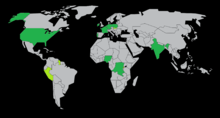Congregation of the Annunciation
The Congregation of the Annunciation (Congregatio Annuntiationis B.M.V.), formerly known as the Belgian Congregation, is a congregation of monasteries within the Benedictine Confederation. Founded in 1920, the Congregation includes fifteen independent male monasteries spread throughout ten countries. Additionally, two female monasteries are members of the Congregation, while a further ten are affiliated with the Congregation. Former Abbot Ansgar Schmidt of St. Matthias' Abbey, Trier, is the current Abbot-President of the Congregation.
History
In 1920, the Belgian Congregation of the Annunciation was founded by three of the great abbeys of Belgium: St. Andrew's Abbey in Bruges, Keizersberg Abbey, and Maredsous Abbey. These monasteries shared descent from the Abbey of Beuron. Their respective abbots, Theodore Neve, Robert de Kerchove, and Columba Marmion, chose to unite their communities into a new congregation.
Yet even before its inception, the international character of the Annunciation Congregation was nascent. Gerard Van Caloen, founder of St. Andrew's Abbey, dreamed of reviving the missionary apostolate of such early Benedictines as Boniface, Apostle of the Germans. While acting as the Beuronese Congregation's procurator in Rome, Van Caloen saw that the Brazilian Congregation was in need of assistance. Thus, in 1898, he facilitated the foundation of St. Andrew's Abbey as a procura for monastic restoration. Upon being raised to an abbey in 1901, St. Andrew's Abbey was incorporated into the Brazilian Congregation.
Under Van Caloen's successor, Abbot Theodore Neve, the monks of St. Andrew's Abbey established mission stations in the Belgian Congo. The abbey would go on to create monastic foundations in China, India, Poland, the United States, and Zaïre. Likewise, Maredsous established an Irish foundation in 1927, which in turn has expanded to Nigeria. The Polish community at Tyniec near Krakow has founded two additional houses in Poland, and one in Slovakia.
Over the years, the Annunciation Congregation has also expanded by incorporating previously-existing abbeys. Thus, the Abbey of St Matthias (Germany), Egmond Abbey (Netherlands), the Abbey of Our Lady of Exile (Trinidad and Tobago), and St Benedict's Abbey, Singeverga (Portugal) have contributed their mature monastic communities to the Congregation.[1]
Governance
Under the Constitutions of the Congregation of the Annunciation, canonical visitations of member houses are conducted four years. Likewise, the General Chapter convenes every four years. The General Chapter, organized at one of the Congregation's European abbeys, brings together a superior and an elected delegate from each of the Congregation's monasteries.
The Abbot President of the Congregation of the Annunciation is Father Ansgar Schmidt, former superior of the Abbey of St Matthias, Trier. The Abbot President is elected every eight years.[2]
List of member houses and dependencies[3]

Africa
- Democratic Republic of the Congo
- Nigeria
- St. Benedict's Priory (1979), Ewu-Ishan
Americas
- Guyana
- Mora Camp, Lower Mazaruni River, Bartica
- Trinidad and Tobago
- Abbey of Our Lady of Exile (1912), Tunapuna
- United States
- St Andrew's Abbey (1956), Valyermo
Asia
Europe
- Belgium
- Monastère Saint-Remacle (1950), Wavreumont
- Monasterio de la Resurreccion, Chucuito, Peru
- Monastère Saint-Andre de Clerlande (1970), Ottignies
- Prieuré de Mambre (1978), Kinshasa, Democratic Republic of the Congo
- Abbaye de Maredsous (1872), Denée
- Sint-Andriesadbdij Zevenkerken (1902), Sint-Andries
- Monastère Saint-Remacle (1950), Wavreumont
- France
- Prieuré Saint-Benoit (1943), Étiolles
- Germany
- Benediktinerabtei St. Matthias, Trier
- Benediktinerpriorat Huysburg, Dingelstedt
- Benediktinerabtei St. Matthias, Trier
- Ireland
- Glenstal Abbey (1927), Murroe
- Netherlands
- Sint Adelbert Abdij (1935), Egmond
- Poland
- Portugal
- Slovakia
- Kláštor Premenenia Pána (2010), Sampor
See also
- Order of Saint Benedict
- Benedictine Confederation
References
- "The Annunciation Congregation". About the Abbey. Monks of Valyermo. Retrieved 1 November 2012.
- "Valyermo and Its Congregation". About the Abbey. Monks of Valyermo. Retrieved 1 November 2012.
- "OSB-International Atlas". Confoederatio Benedictina. Archived from the original on 7 November 2012. Retrieved 1 November 2012.